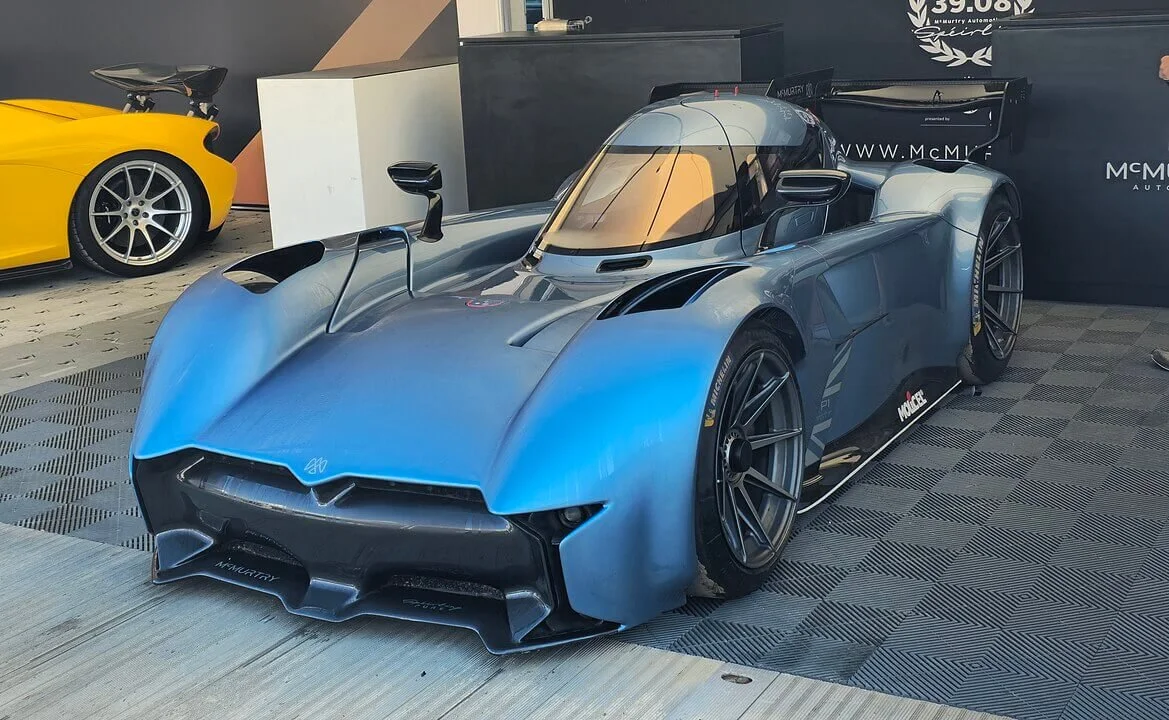McMurtry Spéirling: Das erste Hypercar, das kopfüber fahren kann – ernsthaft
In einer Zeit, in der Elektromobilität oft noch mit „langweilig“ oder „leise“ assoziiert wird, setzt der McMurtry Spéirling ein Zeichen – und zwar ein spektakuläres: Dieses Hypercar schafft es nicht nur, in 1,4 Sekunden von 0 auf 100 km/h zu beschleunigen, sondern kann sich sogar kopfüber an einer Decke festhalten und vorwärts bewegen. Kein Science-Fiction, kein Werbegag – sondern echte Ingenieurskunst, die einen neuen Maßstab in der Welt der straßenzugelassenen Hypercars setzt.
Das Prinzip dahinter: Aktiver Bodeneffekt mit Turbinen-Power
Möglich wird dieses Kunststück durch ein hochentwickeltes Luftansaugsystem: Zwei Hochleistungs-Turbinen unter dem Fahrzeug erzeugen massiven Unterdruck, der das Auto regelrecht an den Boden „saugt“. Im Stillstand erzeugt der Spéirling damit einen Anpressdruck von über 2.000 kg – doppelt so viel wie sein eigenes Fahrzeuggewicht von rund 1.000 kg.
Dieser Effekt reicht theoretisch (und wie nun bewiesen praktisch) aus, um das Fahrzeug kopfüber an einer Deckenkurve haften zu lassen. In einem Test konnte das Fahrzeug sich tatsächlich mehrere Zentimeter kopfüber an einer rotierenden Strecke fortbewegen – eine Weltpremiere.
Technische Superlative: Der Spéirling sprengt die Regeln
Der McMurtry Spéirling ist nicht einfach ein schnelles Elektroauto. Er ist ein technisches Manifest, das zeigt, wie weit Fahrphysik und Elektroantrieb heute gehen können. Die technischen Highlights in Kürze:
0–100 km/h in nur 1,4 Sekunden
Vollständig elektrisch betrieben
Gewicht: ca. 1.000 kg
Anpressdruck: bis zu 2 Tonnen bei Bedarf
Rekordhalter auf mehreren Rennstrecken
Dank des Unterdrucks hat der Spéirling deutlich mehr Grip als konventionelle Hypercars. Er fährt nicht nur schneller, sondern verhält sich auch in Kurven wie ein Fahrzeug aus einer anderen Welt. Selbst in engen Passagen bleibt er stabil – Geschwindigkeiten von über 160 km/h in Haarnadelkurven sind keine Seltenheit.
Der Top Gear-Rundenrekord: Bye bye, Formel 1
Als wäre das noch nicht genug, sorgte der Spéirling kürzlich für Furore auf der Teststrecke von Top Gear, der bekanntesten Automobilshow der Welt. Gesteuert vom legendären, maskierten Rennfahrer The Stig, pulverisierte das Hypercar den bisherigen Rundkursrekord.
In nur 55,9 Sekunden absolvierte der Spéirling die Runde – und damit mehr als 3 Sekunden schneller als ein Formel-1-Renner von Renault, der über 20 Jahre lang den Rekord hielt. Auf diesem Niveau ist das ein gigantischer Unterschied – und ein klares Signal, dass Elektro-Hypercars bereit sind, die Spitze zu übernehmen.
„Kopfüber fahren“: Spielerei oder Zukunftsvision?
Natürlich stellt sich die Frage: Was bringt ein Auto, das kopfüber fahren kann? Die Antwort liegt nicht im praktischen Nutzen, sondern in der Demonstration der technischen Möglichkeiten. Der McMurtry Spéirling zeigt, dass Elektroautos mehr können, als emissionsfrei zu fahren. Sie können dominieren – in Beschleunigung, Anpressdruck und Fahrdynamik.
Das Projekt ist damit nicht nur ein PR-Stunt, sondern ein Fingerzeig auf das, was in der nächsten Generation von Hypercars technisch möglich ist – wenn man nicht in klassischen Grenzen denkt.
Quelle: McMurtry Spéirling Automotive Youtube
Was bedeutet das für die Hypercar-Welt?
Der McMurtry Spéirling ist kein Serienauto, aber ein Meilenstein. Er bringt Elemente aus der Formel 1, dem Prototypensport und Science-Fiction in ein fahrbares, getestetes Gesamtkonzept. Für andere Hersteller wie Rimac, Koenigsegg oder Ferrari ist das eine neue Benchmark – besonders im Bereich aktiver Aerodynamik und Bodenhaftung.
In einer Branche, in der Beschleunigung und Exklusivität allein nicht mehr ausreichen, definiert der Spéirling ein neues Kriterium: die totale Kontrolle.
Fazit: Der McMurtry Spéirling hebt den Begriff Hypercar auf ein neues Level
Ob man ihn für ein Engineering-Wunder, ein extrem nerdiges Spielzeug oder ein zukunftsweisendes Projekt hält – der Spéirling lässt niemanden kalt. Er ist das vielleicht spektakulärste Elektro-Hypercar, das je gebaut wurde. Und vielleicht auch das ungewöhnlichste.
Mit seinem rekordverdächtigen Anpressdruck, der unglaublichen Beschleunigung und dem symbolträchtigen „Kopfüber-Stunt“ ist er eine Kampfansage an die alten Regeln der Fahrphysik. Wer sagt, dass Hypercars nicht auch unter der Straße fahren können?

